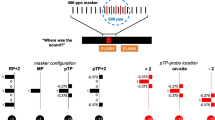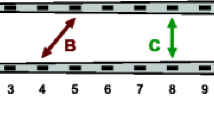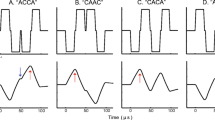Abstract
In today’s cochlear implant (CI) systems, the monopolar (MP) electrode configuration is the most commonly used stimulation mode, requiring only a single current source. However, with an implant that will allow simultaneous activation of multiple independent current sources, it is possible to implement an all-polar (AP) stimulation mode designed to create a focused electrical field. The goal of this experiment was to study the potential benefits of this all-polar mode for reducing uncontrolled electrode interactions compared with the monopolar mode. The five participants who took part in the study were implanted with a research device that was connected via a percutaneous connector to a benchtop stimulator providing 22 independent current sources. The perceptual effects of the AP mode were tested in three experiments. In Experiment 1, the current level difference between loudness-matched sequential and simultaneous stimuli composed of 2 spatially separated pulse trains was measured as function of the electrode separation. Results indicated a strong current-summation interaction for simultaneous stimuli in the MP mode for separations up to at least 4.8 mm. No significant interaction was found in the AP mode beyond a separation of 2.4 mm. In Experiment 2, a forward-masking paradigm was used with fixed equally loud probes in AP and MP modes, and AP maskers presented on different electrode positions. Results indicated a similar spatial masking pattern between modes. In Experiment 3, subjects were asked to discriminate between across-electrode temporal delays. It was hypothesized that discrimination would decrease with electrode separation faster in AP compared to MP modes. However, results showed no difference between the two modes. Overall, the results indicated that the AP mode produced less current spread than MP mode but did not lead to a significant advantage in terms of spread of neuronal excitation at equally loud levels.






Similar content being viewed by others
References
Bierer JA (2007) Threshold and channel interaction in cochlear implant users: evaluation of the tripolar electrode configuration. J Acoust Soc Am 121:1642–1653
Bierer JA, Faulkner KF (2010) Identifying cochlear implant channels with poor electrode-neuron interface: partial tripolar, single-channel thresholds and psychophysical tuning curves. Ear Hear 31:247–258
Blamey P et al (2013) Factors affecting auditory performance of postlinguistically deaf adults using cochlear implants: an update with 2251 patients. Audiol Neurootol 18:36–47
Bonham BH, Litvak LM (2008) Current focusing and steering: modeling, physiology, and psychophysics. Hear Res 242:141–153
Dai H, Micheyl C (2010) On the choice of adequate randomization ranges for limiting the use of unwanted cues in same-different, dual-pair, and oddity tasks. Atten Percept Psychophys 72:538–547
Fielden CA, Kluk K, McKay CM (2014) Interpulse interval discrimination within and across channels: comparison of monopolar and tripolar mode of stimulation. J Acoust Soc Am 135:2913–2922
Fielden CA, Kluk K, McKay CM (2013) Place specificity of monopolar and tripolar stimuli in cochlear implants: the influence of residual masking. J Acoust Soc Am 133:4109–4123
Fraser M, McKay CM (2012) Temporal modulation transfer functions in cochlear implantees using a method that limits overall loudness cues. Hear Res 283:59–69
Friesen LM, Shannon RV, Baskent D, Wang X (2001) Speech recognition in noise as a function of the number of spectral channels: comparison of acoustic hearing and cochlear implants. J Acoust Soc Am 110:1150–1163
Frijns JH, Dekker DM, Briaire JJ (2011) Neural excitation patterns induced by phased-array stimulation in the implanted human cochlea. Acta Otolaryngol 131:362–370
Frijns JH, Kalkman RK, Vanpoucke FJ, Bongers JS, Briaire JJ (2009) Simultaneous and non-simultaneous dual electrode stimulation in cochlear implants: evidence for two neural response modalities. Acta Otolaryngol 129:433–439
Fu Q-J, Shannon RV, Wang X (1998) Effects of noise and spectral resolution on vowel and consonant recognition: acoustic and electric hearing. J Acoust Soc Am 104:3586–3596
Landsberger DM, Galvin JJ (2011) Discrimination between sequential and simultaneous virtual channels with electrical hearing. J Acoust Soc Am 130:1559–1566
Landsberger DM, Padilla M, Srinivasan AG (2012) Reducing current spread using current focusing in cochlear implant users. Hear Res 284:16–24
Long CJ, Holden TA, McClelland GH, Parkinson WS, Shelton C, Kelsall DC, Smith ZM (2014) Examining the electro-neural interface of cochlear implant users using psychophysics, CT scans, and speech understanding. J Assoc Res Otolaryngol 15:293–304
Marks LE, Florentine M (2011) Measurement of loudness, part I: methods, problems and pitfalls. In: Florentine M, Popper AN, Fay RR (eds) Springer handbook of auditory research: loudness. Springer, New-York, pp 17–56
McDermott H (2011) Music perception. In: Zeng FG, Popper AN, Fay RR, (eds) Auditory prostheses: new horizons. Springer, New York, pp 305–339
McKay CM (2012) Forward masking as a method of measuring place specificity of neural excitation in cochlear implants: a review of methods and interpretation. J Acoust Soc Am 131:2209–2224
McKay CM, McDermott HJ (1999) The perceptual effects of current pulse duration in electrical stimulation of the auditory nerve. J Acoust Soc Am 106:998–1009
McKay CM, Henshall KR, Farrell RJ, McDermott HJ (2003) A practical method of predicting the loudness of complex electrical stimuli. J Acoust Soc Am 113:2054–2063
Moore BC, Alcántara JI (2001) The use of psychophysical tuning curves to explore dead regions in the cochlea. Ear Hear 22:268–278
Shannon RV (1983) Multichannel electrical stimulation of the auditory nerve in man. II. Channel interaction. Hear Res 12:1–16
Shannon RV (1992) A model of safe levels for electrical stimulation. IEEE Trans Biomed Eng 39:424–426
Smith ZM (2009) Multi-electrode channel configurations. In: Patent Application Publication (CN102361666A, ed). US
Smith ZM, Parkinson WS, Long CJ (2013) Multipolar current focusing increases spectral resolution in cochlear implants. In: Engineering in Medicine and Biology Society (EMBC), 2013 35th Annual International Conference of the IEEE, pp 2796-2799: IEEE
Srinivasan AG, Padilla M, Shannon RV, Landsberger DM (2013) Improving speech perception in noise with current focusing in cochlear implant users. Hear Res 299:29–36
van den Honert C, Kelsall DC (2007) Focused intracochlear electric stimulation with phased array channels. J Acoust Soc Am 121:3703–3716
Vandali AE, Whitford LA, Plant KL, Clark GM (2000) Speech perception as a function of electrical stimulation rate: using the Nucleus 24 cochlear implant system. Ear Hear 21:608–624
Acknowledgments
The authors would like to thank The Hearing CRC and Robert Briggs, Bev Sheridan, Michelle Knight, Kerrie Plant, Nik Kydas, and John Heasman for their help and support in the clinical management of the participants, Michelle Moran and Arielle Umansky for supplying the clinic-tested speech scores, and finally the editor, Ruth Litovsky, and two anonymous reviewers for their helpful and insightful comments. This project was funded by The Garnett Passe and Rodney Williams Memorial Foundation and supported by Cochlear Ltd. The Bionics Institute acknowledges the support it receives from the Victorian Government through its Operational Infrastructure Support Program.
Author information
Authors and Affiliations
Corresponding author
Rights and permissions
About this article
Cite this article
Marozeau, J., McDermott, H.J., Swanson, B.A. et al. Perceptual Interactions Between Electrodes Using Focused and Monopolar Cochlear Stimulation. JARO 16, 401–412 (2015). https://doi.org/10.1007/s10162-015-0511-2
Received:
Accepted:
Published:
Issue Date:
DOI: https://doi.org/10.1007/s10162-015-0511-2




